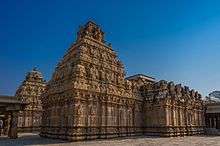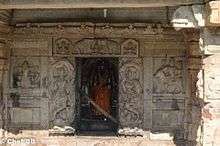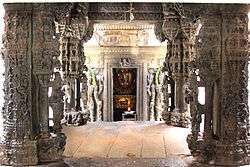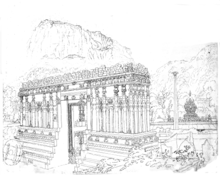Bhoga Nandeeshwara Temple
Bhoga Nandeeshwara Temple (Kannada: ಭೋಗ ನಂದೀಶ್ವರ ದೇವಾಲಯ) (also spelt "Bhoga Nandishwara" or "Bhoga Nandishvara") is a Hindu temple located in Nandi village, at the base of Nandi Hills (or Nandidurga) in the Chikkaballapur district of Karnataka state, India. It is dedicated to the Hindu god Shiva.

| Bhoga Nandeeshwara Temple complex | |
|---|---|
Bhoga Nandeeshwara Temple | |
| Location | Nandi, Chikkaballapura, Chikkaballapura, Karnataka, India |
| Coordinates | 13°23′12″N 77°41′53″E |
| Built | Early 9th century A.D.-16th century |
| Architectural style(s) | Dravidian |
 Location in Karnataka | |

History
The original temple in the complex, identified as one of the oldest temples of Karnataka, dates back to the early 9th century. The earliest inscriptions referring to the construction of the temple for Shiva, according to the Archaeological Survey of India, are from Nolamba dynasty ruler Nolambadiraja and the Rashtrakuta emperor Govinda III dated c.806, and copper plates of the Bana rulers Jayateja and Dattiya of about c.810. The temple was later under the patronage of successive notable South Indian dynasties: the Ganga Dynasty, the Chola dynasty, the Hoysala Empire and the Vijayanagara Empire. In the post medieval era, the local chiefs of Chikaballapura and the rulers of the Mysore Kingdom (Hyder Ali and Tipu Sultan) controlled the region before it eventually came under British rule after the death of Tipu Sultan in c.1799. The architectural style is Dravidian.[1] The temple is located at a distance of 60 km from Bangalore.[2] The temple is protected as a monument of national importance by the Archaeological Survey of India.[3][4][5][6]
Structure

The temple complex has two large shrines: the "Arunachaleswara" shrine to the south built by the Gangas of Talakad, and the "Bhoga Nandeeshwara" shrine to the north built by the Cholas. It has the sculpture of a king considered to be that of Rajendra Chola. In between there is a small intervening shrine called with "Uma-Maheshwara" shrine with a kalyana mantapa ("marriage alter") supported by ornate pillars in black stone with reliefs depicting of the Hindu gods Shiva and his consort Parvati, Brahma (the creator) and Saraswathi, Vishnu (the preserver) and his consort Lakshmi, the god of fire Agni and his consort Swaha Devi, and decorative creepers and birds in bas-relief. This is typical to Hoysala architecture.[1][4]
According to the art historian George Michell, the temple is a typical 9th-10th century Nolamba construction with pilasters on the outer walls of the shrines, perforated decorative stone windows which contain figures, of a dancing Shiva (south wall of the Arunachaleshwara shrine) and Durga standing on a buffalo head (north wall of Bhoga Nandeshwara shrine). Pyramidal and tiered towers (shikhara) rise from the two major shrines. Each major shrine has a large linga in the sanctum (the universal symbol of the god Shiva) with a sculpture of Nandi (the bull) in a pavilion facing the shrine.[5] According to Michell, during the 16th century Vijayanagara period, a pavilion with elegant pillars was added in between the two major shrines. The pillars crafted out of grey-green granite have relief sculptures of attendant maidens. Michell feels the minor "Uma-Maheshwara" shrine was added in between the two major shrines (behind the pavilion) during the post Vijayanagara rule of the Gowdas of the Yelahanka dynasty. The minor shrine has a procession of deities and sages in wall relief. The wall that links the two major shrines was cleverly constructed so as to be in-distinguishable from the two original shrines. A spacious pillared hall was also added in front of the two major shrines.[5][6]
_-_Bhoga_Nandeeshwara_Temple.jpg)
The "Arunachaleswara" and the "Bhoga Nandeeshwara" forms of Shiva represent, according to Hindu legend, two stages in the life of the god Shiva: childhood and youth. The "Uma-Maheshwara" shrine has reliefs depicting the third stage, Shiva's marriage to the goddess Parvati. Hence this shrine is popular with newly weds who come to seek blessing. The Yoga Nandeeshwara temple on top of Nandi hills represents the final "renunciation" stage in the life of Shiva and hence this temple is devoid of any festivities.[4] The large shrines each have a sanctum (garbhagriha), a vestibule (sukanasi) and a closed hall (navaranga or mantapa). The vestibule and hall are provided with perforated stone screens called Jali. Each shrine has a nandi mantapa in front (hall with the sculptured image of Nandi the bull) facing the sanctum. The outer bounding wall (prakara) of the complex has two minor shrines for Devi, the female form of divinity ("divine core of all Hindu goddesses").[1] To the north of the shrines is a second compound with a navaranga mantapa (pavilion) with Yali pillars. Beyond this compound is a large stepped temple tank (kalyani or pushkarni), locally called "Sringeri Teertha" (the mythical source of the Pinakini river) where lamps are lit on certain festive days.[1][4][5][6]
Gallery
 Entrance as seen in 1834
Entrance as seen in 1834 Archaeological Survey of India signboard explaining the original construction was commissioned by Bana King Vidyadhara in 810 A.D.
Archaeological Survey of India signboard explaining the original construction was commissioned by Bana King Vidyadhara in 810 A.D.- View of the large Maha mantapa (main hall), a Vijayanagara empire era construction at the Bhoga Nandeeshvara temple complex
- Kalyani (temple tank):a Vijayanagara era contribution to the Bhoga Nandeeshwara temple complex
- Kalyani or Pushkarni (temple tank) was added by King Krishnadeva Raya at Bhoga Nandeeshvara temple complex
- Window art and relief work at the Bhoganandeeshvara temple complex
.jpg) Yali pillars in the vasantha mantapa, a Vijayanagara era addition at Bhoga Nandeeshvara temple complex
Yali pillars in the vasantha mantapa, a Vijayanagara era addition at Bhoga Nandeeshvara temple complex Yali pillars in the vasantha mantapa, a Vijayanagara era addition at Bhoga Nandeeshvara temple complex
Yali pillars in the vasantha mantapa, a Vijayanagara era addition at Bhoga Nandeeshvara temple complex Yali pillars in the prakara ("bounding wall"), a Vijayanagara era addition at Bhoga Nandeeshvara temple complex
Yali pillars in the prakara ("bounding wall"), a Vijayanagara era addition at Bhoga Nandeeshvara temple complex- Vasantha mantapa ("marriage alter") is a Vijayanagara era contribution to the Bhoga Nandeeshwara temple complex
 Ornate pillar in the large open mantapa is a Vijayanagara era addition to the Bhoga Nandeeshvara temple complex
Ornate pillar in the large open mantapa is a Vijayanagara era addition to the Bhoga Nandeeshvara temple complex- Ornate pillars in the large open mantapa, a Vijayanagara era addition to the Bhoga Nandeeshwara temple complex
- Ornate pillars in the large open mantapa, a Vijayanagara era contribution to the Bhoga Nandeeshwara temple complex
- Ornate pillars of the vasanta mantapa ("marriage alter", facing the Uma-Maheshvara shrine), made of soap stone, is a Hoysala era contribution to the Bhoga Nandeeshvara temple complex
- Ornate pillar of the vasanta mantapa, made of soap stone, is a Hoysala era contribution to the Bhoga Nandeeshvara temple complex
- Ornate pillar of the vasanta mantapa, made of soap stone, is a Hoysala era contribution to the Bhoga Nandeeshvara temple complex
- Ornate pillar of the vasanta mantapa, made of soap stone, is a Hoysala era contribution to the Bhoga Nandeeshvara temple complex
- Open mantapa facing a minor shrine at the rear in the Bhoga Nandeeshwara temple complex
- Entrance to minor shrine at the rear in the Bhoga Nandeeshwara temple complex
 Ornate Pillar carvings of the Vasantha Mantapa
Ornate Pillar carvings of the Vasantha Mantapa Ornate Carvings on the Uma-Maheshswara Shrine
Ornate Carvings on the Uma-Maheshswara Shrine Ornated pillar of Vasanta Mantap
Ornated pillar of Vasanta Mantap Window carving on outerwall of the Arunachaleshswara shrine in the Bhoga Nandeeshvara temple complex
Window carving on outerwall of the Arunachaleshswara shrine in the Bhoga Nandeeshvara temple complex
References
| Wikimedia Commons has media related to Bhoganandishwara Temple. |
- "Bhoganandishwara Temple". Archaeological Survey of India, Bengaluru Circle. ASI Bengaluru Circle. Archived from the original on 2 May 2014. Retrieved 31 May 2015.
- V L, Prakasha. "From here and there". Deccan Herald. Retrieved 27 June 2013.
- "Alphabetical List of Monuments - Karnataka -Bangalore, Bangalore Circle, Karnataka". Archaeological Survey of India, Government of India. Indira Gandhi National Center for the Arts. Retrieved 31 May 2015.
- "Bhoga Nandeeshwara Temple". Karnataka.com. Retrieved 1 June 2015.
- Michell, George (2013), Southern India: A Guide to Monuments Sites & Museums, Chapter: Karnataka, Section: Bengaluru, Sub-section: Nandi, Roli Books Private Limited, ISBN 978-81-7436-920-8
- Miller, Sam (2012), Karnataka: Chapter from Blue Guide India, Chapter: North Bangalore, Section: Bhoganandishwara, Blue Guides,, ISBN 978-1-905131-53-2